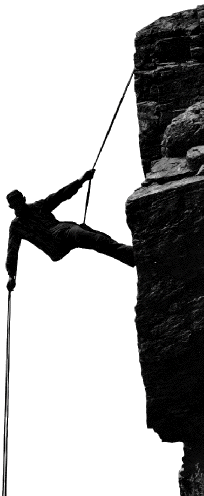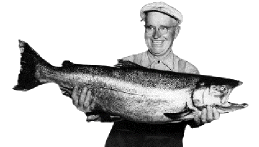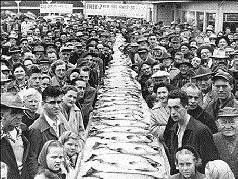By Sharon Boswell
and Lorraine McConaghy
Special to The Times
 Northwest mountains provided exhilarating recreational challenges year-round,
like rappelling down Mount Shuksan at right.
Photo Credit: Bob and Ira Spring.
Northwest mountains provided exhilarating recreational challenges year-round,
like rappelling down Mount Shuksan at right.
Photo Credit: Bob and Ira Spring.
THE SCENIC BEAUTY OF THE NORTHWEST has always drawn visitors to the region.
By the World War II era, tourism became an important business as local chambers of commerce urged
people to explore this "charmed land." Increasingly the area was touted as a "sporting paradise,"
an "evergreen playground" of mountains, waters and forests.
But when wartime gas and tire rationing forced vacations closer to home,
promoters changed their focus, hoping to lure potential residents instead. A special supplement
of The Times saluted the Pacific Northwest as "the ideal place to live, to work, to play and to prosper,"
and 1942 advertisements urged readers "not only to come and play, but to come and stay and share with us
the advantages of this favored region."
Many did stay as the war's industrial needs brought new employment opportunities.
But the increasing demand for natural resources and the effects of rapid population growth also required
a watchful eye to protect both the scenic and recreational potential of the region.
The Mountaineers led the organizations whose mission included both enjoyment and
conservation of the Northwest's natural bounty. The club was founded in 1906 by "lovers of outdoor life,"
including photographer Asahel Curtis. This initial core of hardy hikers, eager to open trails into
the backcountry, had expanded by the late 1930s to include climbing and skiing enthusiasts.
The Mountaineers also lobbied hard to protect wilderness areas by placing them in the public trust.
Instrumental in the development of both the Olympic and Mount Rainier National Parks, members of the organization
argued that only by preserving these lands from commercial development could the region's natural heritage be
preserved.
These parks also offered the types of recreational opportunities outdoorsmen relished,
including fishing, hiking, snowshoeing and camping. But the growing popularity of such activities soon
threatened to overwhelm wilderness-protection goals.
In the wintertime, skiing became a Northwest mania. The few energetic souls willing to
sidestep up mountainsides for the exhilaration of the downhill run soon found the slopes crowded as developers
installed mechanical lifts and groomed trails. The Times Ski School began in 1939, introducing the sport to
Seattle children with free weekly lessons and special trains offering quick trips to the mountains for
only $1 apiece. More than 4,500 were enrolled by 1947 as the program expanded to include students
from throughout King County.
During the warmer months, water skiing replaced the snow variety. Outdoors lovers also took
to the region's many lakes, rivers and bays for swimming and boating. According to promotional columns
in The Times of 1941, however, salmon fishing was Puget Sound's newest boom industry --
"the biggest recreational attraction of Puget Sound country today."

Fishing derbies gained in popularity during the 1940s, offering a sporting adventure and the possibility of big prizes. Ray's Boathouse owner Ray Lichtenberger,at left, held a 25-pound king caught in one contest. The Seattle Times began its derby in 1940.
BY THE END OF THE WAR YEARS, MORE THAN 100 BOATHOUSES like Ray's, Baranof's
and Lloyd's dotted the shores of the Sound, offering rental boats, bait and fishing gear necessary
for a successful day's outing. Credit for building the popularity of this sport was most frequently
attributed to salmon derbies -- fishing competitions which, according to one sportswriter,
added excitement to a pastime "locals" had accepted too casually.
Sporting-goods magnate Ben Paris is usually said to have promoted the first
area derby in 1931; by the 1940s, fishing competitions had proliferated so quickly that nearly
every town along the Sound, as well as numerous businesses and organizations, sponsored one.
Derbies lured thousands to fish every weekend, and for every squawfish hooked there were
also prize-winning kings weighing as much as 62 pounds and silver salmon often averaging 16 pounds or more.
Women-only competitions, kids' contests and the popular "Cracker Derby" for novice anglers helped bring
new enthusiasts to the sport. The rewards grew, too -- prizes of $100 or angling equipment soon gave way
to boats, motors and even cars.
By 1952 the finals of its Silver Salmon Derby, below left, drew more than 850 anglers catching a total of 111 fish. Photo Credit: Seattle Times.

THE SEATTLE TIMES DERBY, BEGUN IN 1940, became one of the most lucrative
in the region,
offering $1,000 cash and five Dodge sedans to the contestants hauling in the largest fish. But its first year
also brought out the worst side of the sport. Anthony Zuanich and three cohorts thought they would beat the
system by buying salmon from the Swinomish Indians and claiming they'd been caught during the competition.
The scheme worked, briefly: The four each took home a new car for lunkers ranging from 22 to 29 pounds.
But derby officials, suspicious that one of the winners didn't know a hook from a plug,
investigated further and uncovered the plot. Several of the cheaters spent time in jail.
Later derbies sought to use their popularity to advocate salmon conservation by promoting
the state's hatchery programs. But the growing numbers of recreational fishermen, as well as those who
made their living by catching fish, continued to put pressure on the species.
In the end, outdoors lovers found that despite their best intentions, they could not
always protect the natural resources that made the region a sporting paradise. Too many people who came
to play had decided to stay.

Some winners of a Times derby, which gave away cars, boats and cash.
Photo Credit: Seattle Times.